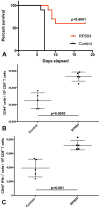Discovery of a protective Rickettsia prowazekii antigen recognized by CD8+ T cells, RP884, using an in vivo screening platform
- PMID: 24146844
- PMCID: PMC3797808
- DOI: 10.1371/journal.pone.0076253
Discovery of a protective Rickettsia prowazekii antigen recognized by CD8+ T cells, RP884, using an in vivo screening platform
Abstract
Rickettsia prowazekii has been tested for biological warfare due to the high mortality that it produces after aerosol transmission of very low numbers of rickettsiae. Epidemic typhus, the infection caused by these obligately intracellular bacteria, continues to be a threat because it is difficult to diagnose due to initial non-specific symptoms and the lack of commercial diagnostic tests that are sensitive and specific during the initial clinical presentation. A vaccine to prevent epidemic typhus would constitute an effective deterrent to the weaponization of R. prowazekii; however, an effective and safe vaccine is not currently available. Due to the cytoplasmic niche of Rickettsia, CD8(+) T-cells are critical effectors of immunity; however, the identification of antigens recognized by these cells has not been systematically addressed. To help close this gap, we designed an antigen discovery strategy that uses cell-based vaccination with antigen presenting cells expressing microbe's proteins targeted to the MHC class I presentation pathway. We report the use of this method to discover a protective T-cell rickettsial antigen, RP884, among a test subset of rickettsial proteins.
Conflict of interest statement
Figures





Similar articles
-
Discovery of novel cross-protective Rickettsia prowazekii T-cell antigens using a combined reverse vaccinology and in vivo screening approach.Vaccine. 2014 Sep 3;32(39):4968-76. doi: 10.1016/j.vaccine.2014.06.089. Epub 2014 Jul 7. Vaccine. 2014. PMID: 25010827 Free PMC article.
-
Thymus-independent antibody production to the antigen of Rickettsia prowazekii.Acta Virol. 1986 May;30(3):256-60. Acta Virol. 1986. PMID: 2874731
-
Rickettsial vaccines with emphasis on epidemic typhus. Initial report of an old vaccine trial.S Afr Med J. 1986 Oct 11;Suppl:73-6. S Afr Med J. 1986. PMID: 3095934 No abstract available.
-
[The current problems in improving the vaccinal prophylaxis of typhus].Zh Mikrobiol Epidemiol Immunobiol. 1995 Jul-Aug;(4):109-11. Zh Mikrobiol Epidemiol Immunobiol. 1995. PMID: 9381858 Review. Russian. No abstract available.
-
[Modern concepts of the localization and vital activity of Rickettsia prowazekii in the infected body in relation to the problem of latent epidemic typhus infection].Tr Inst Im Pastera. 1975;43:110-27. Tr Inst Im Pastera. 1975. PMID: 829915 Review. Russian. No abstract available.
Cited by
-
Phenotype of the anti-Rickettsia CD8(+) T cell response suggests cellular correlates of protection for the assessment of novel antigens.Vaccine. 2014 Sep 3;32(39):4960-7. doi: 10.1016/j.vaccine.2014.07.032. Epub 2014 Jul 18. Vaccine. 2014. PMID: 25043277 Free PMC article.
-
Reporter gene comparison demonstrates interference of complex body fluids with secreted luciferase activity.Sci Rep. 2021 Jan 14;11(1):1359. doi: 10.1038/s41598-020-80451-6. Sci Rep. 2021. PMID: 33446782 Free PMC article.
-
Vaccine Design and Vaccination Strategies against Rickettsiae.Vaccines (Basel). 2021 Aug 12;9(8):896. doi: 10.3390/vaccines9080896. Vaccines (Basel). 2021. PMID: 34452021 Free PMC article. Review.
-
Vaccination against Bacterial Infections: Challenges, Progress, and New Approaches with a Focus on Intracellular Bacteria.Vaccines (Basel). 2022 May 10;10(5):751. doi: 10.3390/vaccines10050751. Vaccines (Basel). 2022. PMID: 35632507 Free PMC article. Review.
-
Rickettsia parkeri with a Genetically Disrupted Phage Integrase Gene Exhibits Attenuated Virulence and Induces Protective Immunity against Fatal Rickettsioses in Mice.Pathogens. 2021 Jun 30;10(7):819. doi: 10.3390/pathogens10070819. Pathogens. 2021. PMID: 34208806 Free PMC article.
References
-
- Bechah Y, Capo C, Mege JL, Raoult D (2008) Epidemic typhus. Lancet Infect Dis 8: 417–426. - PubMed
-
- Azad AF (2007) Pathogenic rickettsiae as bioterrorism agents. Clin Infect Dis 45 Suppl 1S52–S55. - PubMed
-
- Azad AF (1988) Relationship of vector biology and epidemiology of louse- and flea-borne rickettsioses. In: Biology of rickettsial diseases. CRC Press. 51–62.
-
- Moutaftsi M, Bui HH, Peters B, Sidney J, Salek-Ardakani S, et al. (2007) Vaccinia virus-specific CD4+ T cell responses target a set of antigens largely distinct from those targeted by CD8+ T cell responses. J Immunol 178: 6814–6820. - PubMed
Publication types
MeSH terms
Substances
Grants and funding
LinkOut - more resources
Full Text Sources
Other Literature Sources
Research Materials
Miscellaneous

